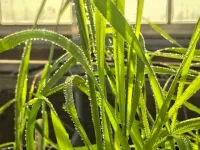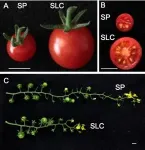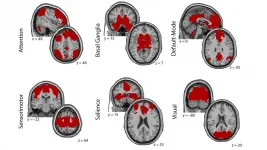(Press-News.org) The United States Department of Agriculture identifies a group of "big eight" foods that causes 90% of food allergies. Among these foods are wheat and peanuts.
Sachin Rustgi, a member of the Crop Science Society of America, studies how we can use breeding to develop less allergenic varieties of these foods. Rustgi recently presented his research at the virtual 2020 ASA-CSSA-SSSA Annual Meeting.
Allergic reactions caused by wheat and peanuts can be prevented by avoiding these foods, of course. "While that sounds simple, it is difficult in practice," says Rustgi.
Avoiding wheat and peanuts means losing out on healthy food options. These two foods are nutritional powerhouses.
Wheat is a great source of energy, fiber, and vitamins. Peanuts provide proteins, good fats, vitamins and minerals.
"People with food allergies can try hard to avoid the foods, but accidental exposure to an allergen is also possible," says Rustgi. Allergen exposure can lead to hospitalization, especially for people with peanut allergies.
"For others, avoiding wheat and peanuts is not easy due to geographical, cultural, or economic reasons," explains Rustgi.
Rustgi and his colleagues are using plant breeding and genetic engineering to develop less allergenic varieties of wheat and peanuts. Their goal is to increase food options for people with allergies.
For wheat, researchers focus on a group of proteins, called gluten.
The gluten in bread flour makes dough elastic. Gluten also contributes to the chewy texture of bread.
But gluten can cause an immune reaction for individuals with Celiac disease. In addition, others experience non-celiac gluten sensitivity, leading to a variety of adverse symptoms.
Researchers have been trying to breed varieties of wheat with lower gluten content. The challenge, in part, lies in the complicated nature of gluten genetics. The information needed to make gluten is embedded in the DNA in wheat cells.
But gluten isn't a single protein - it's a group of many different proteins. The instructions cells needed to make the individual gluten proteins are contained within different genes.
In wheat, these gluten genes are distributed all over a cell's DNA. Since so many portions of the DNA play a role in creating gluten, it is difficult for plant breeders to breed wheat varieties with lower gluten levels.
"When we started this research, a major question was whether it would be possible to work on a characteristic controlled by so many genes," says Rustgi.
For peanuts, the situation is similar. Peanuts contain 16 different proteins recognized as allergens.
"Not all peanut proteins are equally allergenic," says Rustgi. Four proteins trigger an allergic reaction in more than half of peanut sensitive individuals.
Like the gluten genes in wheat, the peanut allergen genes are spread throughout the peanut DNA.
"Affecting this many targets is not an easy task, even with current technology," says Rustgi.
Rustgi and the research team are testing many varieties of wheat and peanuts to find ones that are naturally less allergenic than others.
These low-allergenic varieties can be bred with crop varieties that have desirable traits, such as high yields or pest resistance. The goal is to develop low-allergenic wheat that can be grown commercially.
In addition to traditional breeding efforts, Rustgi is also using genetic engineering to reduce allergenic proteins in wheat and peanuts.
For example, a technology called CRISPR allows scientists to make very precise changes to a cell's DNA.
Rustgi is using CRISPR to target gluten genes in wheat. Recent improvements in CRISPR technology allow researchers to target many genes at once.
Genes targeted by CRISPR are changed or mutated. This means that cells can no longer 'read' these genes to make the specific proteins.
"Disrupting the gluten genes in wheat could yield wheat with significantly lower levels of gluten. A similar approach would work in peanuts," says Rustgi.
Other approaches include understanding how gluten production is regulated in wheat cells. As it turns out, one protein serves as a 'master regulator' for many gluten genes.
That's important because disrupting this master regulator could lead to reduced amounts of gluten in wheat. Targeting a single gene is much easier than trying to disrupt the several gluten genes.
"Wheat and peanuts are the major sources of proteins to many, especially those living in resource-deprived conditions," says Rustgi. "Finding affordable ways to make wheat and peanuts available for all is very important."
Developing wheat and peanuts with reduced allergen levels is a key step toward this goal.
"These crops will also reduce accidental exposure to allergens," says Rustgi. "Also, they would limit the severity of reactions if exposure did happen."
INFORMATION:
Sachin Rustgi is a researcher at Clemson University. This work was supported by South Carolina and National Peanut Boards, Life Sciences Discovery Fund, and Clemson University. The 2020 ASA-CSSA-SSSA Annual Meeting was hosted by the American Society of Agronomy, Crop Science Society of America, and Soil Science Society of America.
Tsukuba, Japan - Tomatoes are one of the most popular types of fresh produce consumed worldwide, as well as being an important ingredient in many manufactured foods.
As with other cultivated crops, some potentially useful genes that were present in its South American ancestors were lost during domestication and breeding of the modern tomato, Solanum lycopersicum var. lycopersicum.
Because of its importance as a crop, the tomato genome sequence was completed and published as long ago as 2012, with later additions and improvements. Now, the team at University of Tsukuba, in collaboration with TOKITA Seed Co. Ltd, have produced high-quality genome sequences of two wild ancestors of tomato from Peru, Solanum pimpinellifolium ...
Children of all ages can completely bypass age verification measures to sign-up to the world's most popular social media apps including Snapchat, Instagram, TikTok, Facebook, WhatsApp, Messenger, Skype and Discord by simply lying about their age, researchers at Lero, the Science Foundation Ireland Research Centre for Software have discovered.
And even potential age verification solutions identified by the research team can be easily sidestepped by children, according to the team's most recent study: Digital Age of Consent and Age Verification: Can They Protect Children?
Lead researcher Lero's Dr Liliana Pasquale, assistant professor at University College ...
Harpy eagles are considered by many to be among the planet's most spectacular birds. They are also among its most elusive, generally avoiding areas disturbed by human activity - therefore already having vanished from portions of its range - and listed by the International Union for the Conservation of Nature (IUCN) as being 'Near-Threatened'.
However, new research led by the University of Plymouth (UK) suggests estimates of the species' current distribution are potentially overestimating range size.
Using a combination of physical sightings and environmental data, they developed a spatial modelling framework which aims to estimate current and past distributions based on the birds' preferred habitat conditions.
The authors then used the model to estimate a ...
Multi-disciplinary researchers at The University of Manchester have helped develop a powerful physics-based tool to map the pace of language development and human innovation over thousands of years - even stretching into pre-history before records were kept.
Tobias Galla, a professor in theoretical physics, and Dr Ricardo Bermúdez-Otero, a specialist in historical linguistics, from The University of Manchester, have come together as part of an international team to share their diverse expertise to develop the new model, revealed in a paper entitled 'Geospatial distributions reflect temperatures of linguistic feature' authored by Henri Kauhanen, Deepthi Gopal, ...
(Scottsdale, Ariz. - January 27, 2021) HIRREM (the legacy research technology of Cereset - a Brain State Company) was utilized by the Wake Forest School of Medicine to study symptoms of traumatic stress in military personnel before and after use of Cereset (legacy) intervention.
Whole brain, resting state magnetic resonance imaging (MRI) was done pre- and post- Cereset intervention. Significant effects on brain network connectivity have been previously reported.
For the current study, lateralization of brain connectivity was analyzed. Lateralization here refers to the distribution of brain connections within the right, and left side, or to the opposite side. This is important because common lobes in the ...
Montreal, January 27, 2021 - Taking cannabidiol, a chemical in the cannabis sativa plant, isn't an effective way to reduce your dependence on cocaine, researchers at the CHUM Research Centre find.
In North America, close to 5.5 million people use cocaine regularly, and nearly one in five becomes addicted, developing cocaine use disorder, for which there is no clinical treatment. One solution has been touted, however: treatment with cannabidiol.
Better known as CBD, it's a chemical in the cannabis sativa plant known for its protective effects on the brain and liver. But there is very little scientific evidence to support its use as a treatment for addiction.
In fact, in a study published ...
Stopping the spread of COVID-19 is difficult enough. It's even more complicated and confusing when information and resources provided by governments are largely inaccessible to a variety of disabled populations. A newly-published global survey of national health authority websites in nearly 200 countries has directly quantified COVID-19 information accessibility.
The survey, published on January 27, 2021 in the journal Frontiers in Medicine, was conducted by researchers and medical professionals from Bar-Ilan University's Azrieli Faculty of Medicine, the Galilee Medical Center and Tel Aviv ...
As the climate warms and Arctic sea ice retreats, research vessels and commercial ships are sailing into the Arctic Ocean more and more, but the accuracy and sensitivity of regional weather and marine forecasts for these hazardous waters still lag well behind those of their lower-latitude counterparts, with significant differences between regional models. Direct measurements of atmospheric conditions, such as cloud cover and solar radiation, can help to evaluate and improve these models.
In a new study published in the Journal of Geophysical Research: Atmospheres, a research team led by the National Institute of Polar Research in Tachikawa, ...
Sophia Antipolis, 27 January 2021: Pregnancy complications and early menopause increase women's future risk of heart disease. Cardiologists, gynaecologists and endocrinologists recommend how to help middle-aged women prevent later heart problems in a European Society of Cardiology (ESC) consensus document published today in European Heart Journal, a journal of the ESC.1
"Physicians should intensify the detection of hypertension in middle-aged women," states the document. Up to 50% of women develop high blood pressure before the age of 60 but the symptoms - for example hot flushes and palpitations - are often attributed ...
Researchers from Queen Mary University of London and Zhengzhou University have developed a powerful therapeutic platform that uses a modified virus for the treatment of pancreatic cancer. By using the virus in combination with other drugs, the treatment significantly extended survival in preclinical models of pancreatic cancer.
Viruses that can selectively infect and destroy cancer cells, known as oncolytic viruses, are a promising new class of therapeutics for cancer. Through various mechanisms, oncolytic viruses kill cancer cells and elicit strong anti-tumour immune responses. However, current oncolytic virotherapy is unable to produce a long-term cure in patients, and the treatment has to be delivered directly into the tumour - a route that is not feasible for deeply embedded ...






